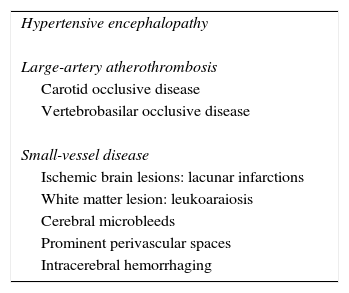During 2013 and the first months of 2014, numerous studies have been published in the cardiovascular field. New guidelines have appeared for managing arterial hypertension and reducing cardiovascular risk by lowering cholesterol levels. New data have emerged on the considerable lipid-lowering efficacy of monoclonal antibodies against PCSK-9, in contrast, however, to the clinical trials directed toward raising HDL-cholesterol with nicotinic acid, which have not shown a reduction in the rate of cardiovascular complications. In the field of hypertension, neither stent placement in patients with renovascular hypertension nor sympathetic denervation in patients with resistant hypertension has been shown to be effective in reducing blood pressure. In terms of antithrombotic treatment, the pharmacogenetic tests do not seem useful for maintaining patients anticoagulated with warfarin within the therapeutic range for longer periods. Moreover, there is increasing evidence that, for patients with coronary artery disease and atrial fibrillation, antiplatelet therapy adds no benefit to anticoagulation therapy and is associated with a greater risk of bleeding. Lastly, a Mediterranean diet could prevent the onset of diabetes, while bariatric surgery could be a reasonable option for improving the disease in patients with obesity. Many of these studies have immediate practice applications in daily clinical practice.
Durante el año 2013 y los primeros meses de 2014 se han publicado numerosos estudios relevantes en el campo cardiovascular. Han aparecido nuevas guías para el manejo de la hipertensión arterial y para reducir el riesgo cardiovascular descendiendo el colesterol. También han aparecido nuevos datos sobre la gran eficacia hipolipidemiante de los anticuerpos monoclonales frente a PCSK-9, decepcionando, sin embargo, los ensayos clínicos dirigidos a elevar el colesterol-HDL con ácido nicotínico, los cuales no han demostrado una reducción de la tasa de complicaciones cardiovasculares. Tampoco en el campo de la hipertensión, la colocación de un stent en pacientes con hipertensión renovascular, o la denervación simpática en pacientes con hipertensión resistente, han demostrado ser eficaces para reducir la presión arterial. Con relación al tratamiento antitrombótico, los test farmacogenéticos no parecen útiles para mantener más tiempo en rango terapéutico a los pacientes anticoagulados con warfarina. A su vez, cada vez existen más evidencias de que en pacientes con enfermedad coronaria y fibrilación auricular, la antiagregación no añade beneficio a la anticoagulación y se asocia con un mayor riesgo de sangrado. Por último, una dieta de tipo mediterráneo podría prevenir la aparición de diabetes, mientras que la cirugía bariátrica podría ser una opción razonable para mejorar la enfermedad en pacientes obesos. Muchos de estos estudios tienen una aplicación práctica inmediata en el trabajo clínico diario.
Article
Diríjase desde aquí a la web de la >>>FESEMI<<< e inicie sesión mediante el formulario que se encuentra en la barra superior, pulsando sobre el candado.

Una vez autentificado, en la misma web de FESEMI, en el menú superior, elija la opción deseada.

>>>FESEMI<<<










